“On good weather days, I enjoy biking to work. Occasionally, that means I have to set off before the sun’s up. I had a scare the other morning when I was nearly T-boned by an SUV leaving a parking lot. That prompted me to buy some reflective tape for my bike frame and a high-visibility vest. Now drivers approaching me from any angle will see me coming.”
– Desmond, Vancouver, BC

In British Columbia, we’re fortunate enough to enjoy world-class cycling conditions nearly year-round. But with this privilege comes responsibility. We explain ten important rules of the road for cyclists in BC.
What you should know
Under BC law, a cyclist has the same rights and duties as the driver of a vehicle. That means you can use the road in the same way as the driver of a vehicle (with some limitations). As well, drivers must show you the same respect and courtesy they show other drivers on the road.
As a cyclist, you’re also subject to the same rules of the road as drivers. For example, you must:
obey speed limits
stop at stop signs
ride on the correct side of the road
signal when you’re going to stop or turn (more on this below)
An important note: some jurisdictions in BC have bylaws that apply specifically to cyclists. Check with your local municipality for cycling-specific bylaws in your area.
Find local cycling bylaws
On CivicInfo BC, you can search across local government websites province-wide to find local bylaws relating to cycling in your community. In the search box, type in bicycle bylaws and the name of your community. For example, to find cycling bylaws for Victoria, you could type bicycle bylaws victoria.
Under the law in BC, all cyclists must wear a proper bicycle helmet when riding on a road or highway. A proper helmet is one that meets certain specifications set out in the law.
Generally, a bicycle helmet should:
have a smooth outer surface,
be built so it’s capable of absorbing energy on impact,
be strongly attached to a strap designed to be fastened under your chin, and
be undamaged.
Shopping for a bike helmet
When shopping for a new bike helmet, look for a sticker saying that it meets safety standards. Here’s a list of the standards accepted in BC.
Exceptions to the helmet requirement
Under BC law, certain people are exempt from the bike helmet requirement. They include:
someone for whom wearing a helmet would interfere with a religious practice
the operator and passengers of a pedicab or quadricycle
someone unable to wear a helmet for medical reasons (with a certificate issued by the superintendent of motor vehicles to prove it)
a child under age 12 who’s riding a chainless three- or four-wheeled bike designed for children
“I love riding my bike around the city, but sometimes I worry about how much care other users of the road are taking. The other day, I was riding on a busy street and had a close call. There was no bike lane so I was riding beside the traffic, next to the curb. As I approached the intersection a car in front of me made a right turn across my path — with no signal or shoulder check from the driver. Luckily I was riding slowly and was able to hit the brakes in time.”
– Stacy, Victoria, BC
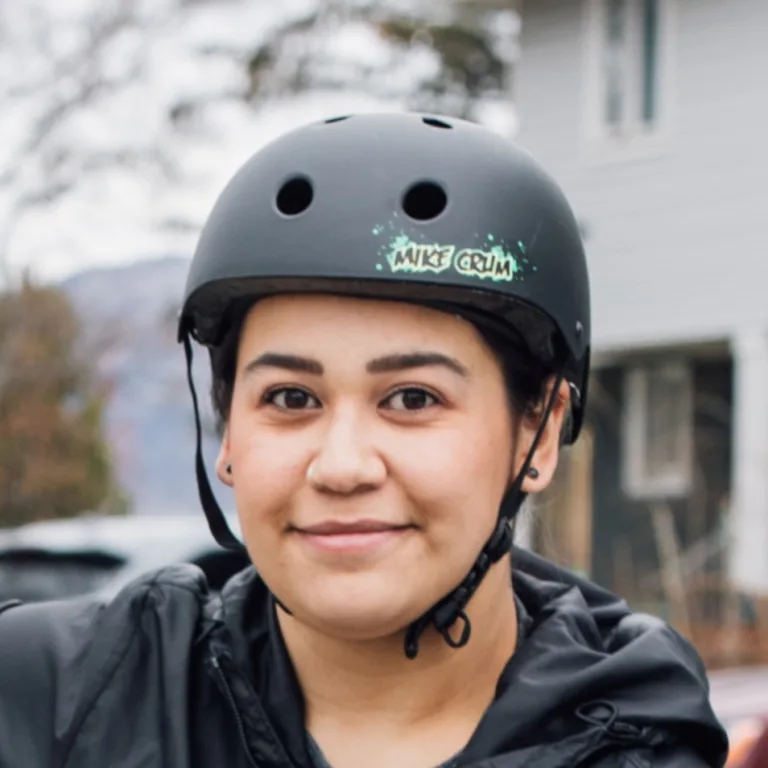
Under BC law, you mustn’t ride your bike without due care and attention or without reasonable consideration for others around you.
If you use common sense and ride defensively, it’s likely that you’ll meet this requirement. Even so, there are many ways to fall afoul of this law. Here are some tips to avoid getting ticketed for careless cycling:
Don’t ride excessively fast. What’s considered excessive depends on the circumstances. Just because you’re within the speed limit doesn’t mean you’re riding with due care and attention.
Make sure you’re visible to others. This is especially important if you’re riding in the dark. Wear bright clothing and consider applying reflective tape to your bike frame.
Be aware of your surroundings. Keep an eye out for vehicles and pedestrians around you. Try to anticipate the movements of other road users. Make eye contact whenever possible.
Sharpen your traffic skills. Make sure you understand the rules of the road. If you’re unfamiliar with traffic rules — or you just want to bone up — check out ICBC’s guide on the topic.
The fine for riding without due care and attention or reasonable consideration for others is $109.
Brush up on your cycling smarts
For a primer on traffic skills for cyclists, check out the BC Cycling Coalition’s guide.
Under the law in BC, cyclists must ride as close as practicable to the right side of the road. But this doesn't mean you need to hug the curb or put yourself in harm’s way. Always give yourself some room to manoeuvre around hazards (such as sewer grates). A good rule of thumb is to ride one metre from the curb.
If there’s not enough space for you to ride safely between the rightmost traffic lane and the curb, you may need to take a lane on the road. In other words, you may need to ride in the centre of the rightmost traffic lane. This can be safer than riding beside the curb and having drivers try to squeeze past you.
Taking a lane may not be appropriate on a high-speed road, or where you’re riding more slowly than traffic. As well, it’s important to stay within your comfort zone. If you’re uneasy riding in a traffic lane, consider planning an alternate route where you can stick to bike lanes or where traffic is lighter.
Use your best judgment
In BC, there isn’t currently a hard-and-fast rule for how far to the right cyclists need to ride. Make your best judgment call in the situation, and always give yourself some leeway to handle unexpected hazards.
It can be difficult for others to spot you when you ride at night or early in the morning. Under BC law, cyclists are required to use certain equipment to make themselves more visible. If you’re biking on a road or highway between half an hour after sunset and half an hour before sunrise, you must have:
a white light mounted on the front of your bike that shines at least 150 metres ahead
a red reflector
a red light mounted on the back of your bike
Many rear red bike lights are designed to work as reflectors as well, so you may not need to buy both.
Use reflective materials to make yourself more visible
Lights on the front and rear of your bike are primarily for traffic in front and behind you. Cars approaching from the side may still have trouble seeing you. So consider wearing reflective clothing or applying reflective tape to the frame of your bike.
Like drivers, cyclists are required by law to let others on the road know when they plan to stop or turn. But unlike drivers, cyclists can’t do so with the flip of a switch. Instead, they use hand signals to let others know their plans.
Here’s how to signal as a cyclist:
If you’re turning left, extend your left arm out horizontally from your bike.
If you’re turning right, extend your left arm out and your forearm up, making a right angle. Or you can extend your right arm out horizontally.
If you’re stopping or slowing down, extend your left arm out and your forearm down.

Photo: The BC Cycling Coalition
Under the law in BC, cyclists aren’t allowed to ride on the sidewalk or crosswalks unless a bylaw or sign allows it. If you need to use the sidewalk or a crosswalk, you must get off your bike and walk.
Many BC municipalities have bylaws that carve out exceptions to this rule. For example, cyclists in Vancouver are allowed to use the sidewalk when riding across the Lions Gate Bridge.
Another common exception is crosswalks with “elephant feet.” These are dots that run parallel to crosswalk markings. They tell cyclists they don’t need to dismount as they would at a regular crosswalk.
Photo: City of North Vancouver
One of the most contentious issues for drivers and cyclists alike is how to pass slower-moving traffic. Under the law in BC, cyclists can pass slower-moving traffic on the left provided it’s safe to do so.
Things aren’t as straightforward when it comes to passing on the right. Under BC law, you can only pass on the right when:
the vehicle you’re passing is making a left turn,
there’s an unobstructed lane to your right that you can ride in, or
you’re on a one-way street and the road is unobstructed and wide enough to accommodate two lanes of traffic.
You cannot pass on the right if it would be unsafe to do so or if it would require you to ride off the road.
What counts as an “unobstructed lane”
There’s no clear-cut legal definition of what constitutes an “unobstructed lane.” The courts in BC have said it’s usually acceptable for a cyclist to pass on the right if they use a bike lane. In some circumstances, it may be okay to pass on the right if there’s plenty of room between traffic and the curb, or there’s a wide shoulder.
To be on the safe side, you should only pass on the right in two circumstances:
when the vehicle you’re passing is turning left, or
when you’re in a bike lane.
You shouldn’t pass on the right when:
traffic is moving,
there’s a street, driveway, or parking spot the vehicle can drive into, or
when there’s less than 1.5 metres between traffic and the curb.
Let others know when you’re passing
If you intend to pass a cyclist or pedestrian, give them some warning. Use your bell (if you have one) or your voice. For example, say “on your right” when passing someone on the right.
Motorists are required to keep a safe passing distance
BC’s driving laws set out rules aimed at protecting vulnerable road users, including cyclists. Under this law, drivers are required to provide a minimum amount of space when passing a cyclist. The minimum safe passing distances are:
areas where the speed limit 50 km/h or less: 1 metre
areas where the speed limit is more than 50 km/h: 1.5 metres
in a separated and protected bike lane or on the sidewalk: 0.5 metres
The measurement starts from the furthest part of the vehicle (for example, the side mirror) to the furthest part of the cyclist or their equipment (for example, the handlebars). For details, see the provincial government's website.
Bike lanes are designated lanes on the road for the exclusive use of cyclists. Usually, bike lanes are separated from regular traffic lanes by a solid white line and marked with a diamond and a bicycle symbol. When you’re riding in a designated bike lane, you have the right of way. Other vehicles must yield to you and other cyclists using the bike lane.
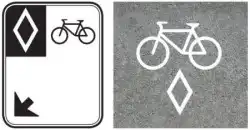
Photo: City of Vancouver
Under BC law, motorists aren’t allowed to drive or park in bike lanes (unless a bylaw says otherwise). One exception is when a motorist needs to cross a bike lane to turn into or leave a driveway or alley. Another is when the bike lane intersects a street. To alert cyclists and motorists to these areas of potential conflict, most BC cities use green paint.
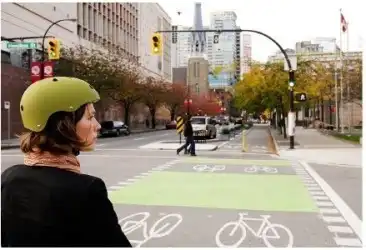
Photo: City of Vancouver
Many municipalities have their own bylaws around bike lanes. For example, Kelowna has a bylaw that requires cyclists to ride in bike lanes where they’re available.
Bike paths and bike routes
A bike path (or shared-use path) is a path designed specifically for cyclists or pedestrians. Motorists aren’t allowed on them. Bike paths are usually marked by a symbol of a person and a bicycle.
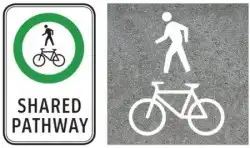
Photo: City of Vancouver
A bike route is a recommended road for cyclists to travel on. You still need to share the road with motorists, but the route is typically optimized for bicycle traffic. Bike routes are marked by a bicycle symbol with an arrow.
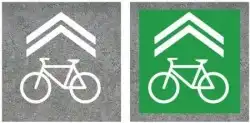
Photo: City of Vancouver
Under the law in BC, drivers are required to make sure it’s safe before opening their door into oncoming traffic. Despite this rule, “dooring” is a leading cause of cycling injuries in BC. Dooring is when someone in a parked car opens their door into the path of a cyclist, who collides with it.
The best way to protect yourself from becoming a dooring victim is by riding defensively. Here are some tips to stay safe:
ride no closer than one metre from parked cars
if you see a parked car that’s occupied, be extra careful
don’t swerve in and out between parked cars
be extra aware in school zones and streets with lots of restaurants and shops
check for lit brakes on parked vehicles
Take action
Curious about your rights and options if you’re ticketed for a cycling offence? Check out our guidance on if you get a ticket as a cyclist.


